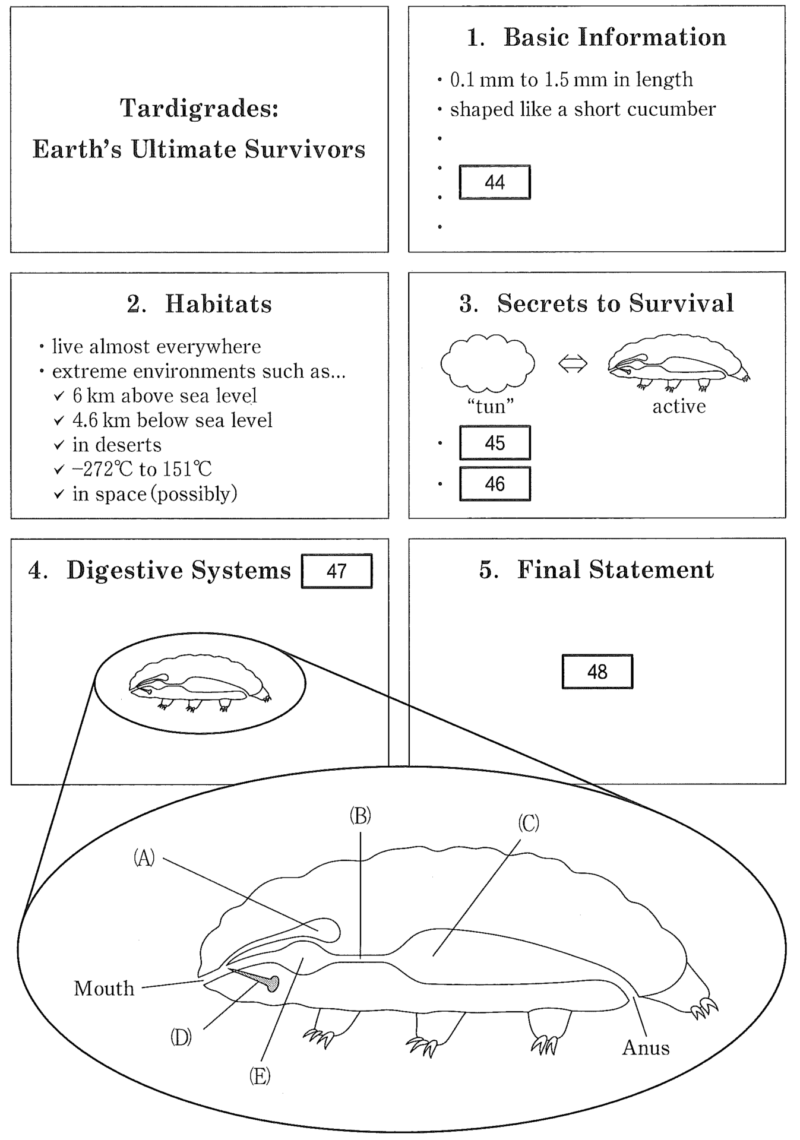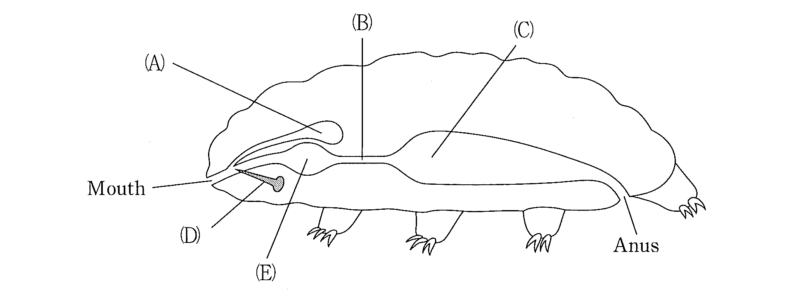2023年度の大学入学共通テスト英語第6問Bの解説をしています。疑問点が残らないよう、解き方の手順も踏まえて一問一問どこよりも丁寧に説明します。
問題
You are in a student group preparing for an international science presentation contest. You are using the following passage to create your part of the presentation on extraordinary creatures.
Ask someone to name the world’s toughest animal, and they might say the Bactrian camel as it can survive in temperatures as high as 50℃, or the Arctic fox which can survive in temperatures lower than -58℃. However, both answers would be wrong as it is widely believed that the tardigrade is the toughest creature on earth.
Tardigrades, also known as water bears, are microscopic creatures, which are between 0.1 mm to 1.5 mm in length. They live almost everywhere, from 6,000-meter-high mountains to 4,600 meters below the ocean’s surface. They can even be found under thick ice and hot springs. Most live in water, but some tardigrades can be found in some of the driest places on earth. One researcher reported finding tardigrades living under rocks in desert without any recorded rainfall for 25 years. All they need are a few drops or thin layer of water to live in. When the water dries up, so do they. They lose all but three percent of their body’s water and their metabolism shows down to 0.01% of its normal speed. The dried-out tardigrade is now in a state called “tun,” a kind of deep sleep. It will continue in this state until it is once again soaked in water. Then, like a sponge, it absorbs the water and springs back to life again as if nothing has happened. Whether the tardigrade is in tun for 1 week or 10 years does not really matter. The moment it is surrounded by water, it comes alive again. When tardigrades are in a state of tun, they are so tough that they can survive in temperatures as low as -272℃ and as high as 151℃. Exactly how they achieve this is still not fully understood.
Perhaps even more amazing than their ability to survive on earth ─ they have been on earth for some 540 million years ─ is their ability to survive in space. In 2007, a team of European researchers sent a number of living tardigrades into space on the outside of a rocket for 10 days. On their return to earth, the researchers were surprised to see that 68% were still alive. This means that for 10 days most were able to survive X-rays and ultraviolet radiation 1,000 times more intense than here on earth. Later, in 2019, an Israeli spacecraft crashed onto the moon and thousands of tardigrades in a state of tun were spilled onto its surface. Whether these are still alive or not is unknown as no one has gone to collect them ─ which is a pity.
Tardigrades are shaped like a short cucumber. They have four short legs on each side of their bodies. Some species have sticky pads at the end of each leg, while others have claws. There are 16 known claw variations, which help identify those species with claws. All tardigrades have a place for eyes, but not all species have eyes. Their eyes are primitive, only having five cells in total ─ just one of which is light sensitive.
Basically, tardigrades can be divided into those that eat plant matter, and those that eat other creatures. Those that eat vegetation have a ventral mouth ─ a mouth located in the lower part of the head, like a shark. The type that eats other creatures has a terminal mouth, which means the mouth is at the very front of the head, like a tuna. The mouths of tardigrades do not have teeth. They do, however, have two sharp needles, called stylets, that they use to pierce plant cells or the bodies of smaller creatures so the contents can be sucked out.
Both types of tardigrade have rather simple digestive systems. The mouth leads to the pharynx (throat), where digestive juices and food are mixed. Located above the pharynx is a salivary gland. This produces the juices that flow into the mouth and help with digestion. After the pharynx, there is a tube which transports food toward the gut. This tube is called the esophagus. The middle gut, a simple stomach/intestine type of organ, digests the food and absorbs the nutrients. The leftovers then eventually move through to the anus.
Your presentation slides:

問1 Which of the following should you not include for ( 44 )?
- eight short legs
- either blind or sighted
- plant-eating or creature-eating
- sixteen different types of feet
- two stylets rather than teeth
問2 For the Secrets to Survival slide, select two features of the tardigrade which best help it survive. (The order does not matter.) ( 45 )・( 46 )
- In dry conditions, they metabolism drops to less than one percent of normal.
- Tardigrades in a state of tun are able to survive in temperatures exceeding 151℃.
- The state of tun will cease when the water in a tardigrade’s body is above 0.01%.
- Their shark-like mouths allow them to more easily eat other creatures.
- They have an ability to withstand extreme levels of radiation.
問3 Complete the missing labels on the illustration of a tardigrade for the Digestive Systems slide.
1. (A) Esophagus
(D) Stylets
2. (A) Pharynx
(D) Esophagus
3. (A) Salivary gland
(D) Stylets
4. (A) Salivary gland
(D) Esophagus
5. (A) Stylets
(D) Middle gut
(B) Pharynx
(E) Salivary gland
(B) Stylets
(E) Middle gut
(B) Esophagus
(E) Pharynx
(B) Middle gut
(E) Pharynx
(B) Salivary gland
(E) Esophagus
(C) Middle gut
(C) Salivary gland
(C) Middle gut
(C) Stylets
(C) Pharynx
問4 Which is the best statement for the final slide?
- For thousands of years, tardigrades have survived some of the harshest conditions on earth and in space. They will live longer than humankind.
- Tardigrades are from space and can live in temperatures exceeding the limits of the Arctic fox and Bactrian camel, so they are surely stronger than human beings.
- Tardigrades are, without a doubt, the toughest creatures on earth. They can survive on the top of mountains; at the bottom of the sea; in the waters of hot springs; and they can also thrive on the moon.
- Tardigrades have survived some of the harshest conditions on earth, and at least one trip into space. This remarkable creature might outlive the human species.
問5 What can be inferred about sending tardigrades into space?
- Finding out whether the tardigrades can survive in space was never thought to be important.
- Tardigrades, along with other creatures that have been on earth for millions of years, can withstand X-rays and ultraviolet radiation.
- The Israeli researchers did not expect so many tardigrades to survive the harsh environment of space.
- The reason why no one has been to see if tardigrades can survive on the moon’s surface attracted the author’s attention.
解説 問1
Which of the following should you not include for ( 44 )?
次のうち、( 44 )に含めてはいけないものはどれですか?
( 44 )はスライドの「1. Basic Information」の項目です。「クマムシ」の「基本情報」ですね。そこに含めてはいけないものを選ぶ問題です。
選択肢を確認しましょう。
1. eight short legs
短い8本の足
第四段落にこうあります。
They have four short legs on each side of their bodies.
体の両側に 4 本の短い脚があります
両側にありますから、4×2=8 で、8本の足があります。この選択肢は正しい記述です。
2. either blind or sighted
目が見えない、あるいは見える
第四段落にこうあります。
All tardigrades have a place for eyes, but not all species have eyes.
すべてのクマムシには目の場所がありますが、すべての種に目があるわけではありません
not all で「全てではない」という部分否定になっています。つまり目のあるクマムシもいれば、目のないクマムシもいるということです。この選択肢は正しい記述です。
3. plant-eating or creature-eating
植物を食べるか、生き物を食べるか
第五段落にこうあります。
Basically, tardigrades can be divided into those that eat plant matter, and those that eat other creatures.
基本的に、クマムシは植物を食べるものと他の生き物を食べるものに分けられます。
ということで、この選択肢は正しい記述です。
4. sixteen different types of feet
16種類の足
第四段落にこうあります。
Some species have sticky pads at the end of each leg, while others have claws. There are 16 known claw variations, which help identify those species with claws.
各脚の端に粘着パッドがある種もあれば、爪がある種もあります。知られている 16 の爪のバリエーションがあり、これらの種を爪で識別するのに役立ちます
まず足に爪があるものとないものに分けられます。そしてその爪が16種類あります。足が16種類あるのではありません。これが、含めてはいけない選択肢です。
5. two stylets rather than teeth
歯ではなく、二つのスタイレット
第五段落にこうあります。
The mouths of tardigrades do not have teeth. They do, however, have two sharp needles, called stylets, that they use to pierce plant cells or the bodies of smaller creatures so the contents can be sucked out.
クマムシの口には歯がありません。ただし、スタイレットと呼ばれる 2 本の鋭い針があり、植物の細胞や小さな生き物の体を突き刺して内容物を吸い出すことができます。
ということで、この選択肢は正しい記述です。
含めてはいけないものを選ぶ問題ですので、正解は「4」です。

「基本情報」だから最初に書かれてあるだろうと思いましたが、なんと後半に該当部分がありました。焦らずにやりたいです。
解説 問2
For the Secrets to Survival slide, select two features of the tardigrade which best help it survive. (The order does not matter.) ( 45 )・( 46 )
Secrets to Survival のスライドでは、クマムシの生存に最も役立つ特徴を 2 つ選択してください(順番は問いません)
正しいものを二つ選ぶ問題です。
選択肢を確認しましょう。
1. In dry conditions, they metabolism drops to less than one percent of normal.
乾燥した状態では、代謝は通常の 1% 未満に低下します。
第二段落にこうあります。
their metabolism shows down to 0.01% of its normal speed.
代謝は通常の速度の 0.01% まで低下します
0.01%に下がっていますから、当然これは 1%未満です。この選択肢が正解です。
2. Tardigrades in a state of tun are able to survive in temperatures exceeding 151℃.
tun の状態のクマムシは、151℃を超える気温でも生き残ることができます
第二段落にこうあります。
When tardigrades are in a state of tun, they are so tough that they can survive in temperatures as low as -272℃ and as high as 151℃.
クマムシが tun の状態にあるとき、彼らは非常に丈夫で、-272℃の低温と151℃の高温で生き残ることができます
151℃で生き残ることができると書いてありますが、151℃を超える気温で生き残るとは書かれてありません。この選択肢は違います。
3. The state of tun will cease when the water in a tardigrade’s body is above 0.01%.
クマムシの体内の水分が 0.01% を超えると、tun の状態は終了します。
第二段落にこうあります。
They lose all but three percent of their body’s water
彼らは体の水分の 3% を除くすべてを失います
水分が3%残った状態で tun になりますから、この選択肢は違います。
4. Their shark-like mouths allow them to more easily eat other creatures.
彼らのサメのような口は、他の生き物をより簡単に食べることを可能にします.
第五段落にこうあります。
Those that eat vegetation have a ventral mouth ─ a mouth located in the lower part of the head, like a shark.
植物を食べるものは、サメのように頭の下部に位置する口である ventral mouth があります
サメのような口をするクマムシは、他の生き物を食べるのではなく、植物を食べます。この選択肢は違います。
5. They have an ability to withstand extreme levels of radiation.
彼らは極端なレベルの放射線に耐える能力を持っています。
第三段落にこうあります。
This means that for 10 days most were able to survive X-rays and ultraviolet radiation 1,000 times more intense than here on earth.
これは、10 日間、地球上の 1,000 倍の強度の X 線と紫外線に耐えることができたことを意味します
この選択肢が正解です。
ということで、正解は「1」「5」です。

該当部粉が散らばっています。とりあえず第二段落を読んだ段階で問題にあたり、「1」「2」「3」の判断をつけることになります。その段階でその他の選択肢にも目を通して、該当部分が出てくるたびに、それに対処するという感じになるでしょう。解答手順が難しいですね。
解説 問3
Complete the missing labels on the illustration of a tardigrade for the Digestive Systems slide.
消化器系のスライドのクマムシの図にあるラベルの欠落を完成させてください

この図の(A)~(E)に当てはまるものを選ぶ問題です。「消化器系」に関しては、第六段落にあります。
The mouth leads to the pharynx (throat), where digestive juices and food are mixed.
口は、消化液と食べ物が混ざり合う pharynx(のど)につながっています。
ということで普通に考えれば、(E) が Pharynx と考えられます。ただこの記述だけでは (A) の可能性も捨てきれません。
続きにこうあります。
Located above the pharynx is a salivary gland.
pharynx の上には salivary gland があります。
ということで、(A) が Salivary gland で、(E) が Pharynx とわかります。
After the pharynx, there is a tube which transports food toward the gut. This tube is called the esophagus.
pharynx の後には、食べ物を腸に運ぶ管があります。 この管は esophagus と呼ばれます
ということで、(B) が Esophagus とわかります。
The middle gut, a simple stomach/intestine type of organ, digests the food and absorbs the nutrients.
単純な「胃/腸」タイプの臓器である middle gut は、食物を消化し、栄養素を吸収します
この文だけでは判断できませんが、話の流れから考えて、(C) が Middle gut ですね。
では (D) は何なのでしょう。実はそれは、第五段落の最後のあります。
They do, however, have two sharp needles, called stylets, that they use to pierce plant cells or the bodies of smaller creatures so the contents can be sucked out.
ただし、stylet と呼ばれる 2 本の鋭い針があり、植物の細胞や小さな生き物の体を突き刺して内容物を吸い出すことができます。
ということで、(D) が Stylets です。
まとめますと、(A) Salivary gland (B) Esophagus (C) Middle gut (D) Stylets (E) Pharynx なので、正解は「3」です。

実際は (E) が Pharynx で、(C) が Middle gut くらいで、選択肢を絞ってしまう感じでしょうか。ちなみに「(A) 唾液腺 (B) 食道 (C) 中腸 (D) スタイレット (E) 咽頭」です。
解説 問4
Which is the best statement for the final slide?
最後のスライドに最も適切な記述はどれですか
選択肢を確認しましょう。
1. For thousands of years, tardigrades have survived some of the harshest conditions on earth and in space. They will live longer than humankind.
何千年もの間、クマムシは地球上および宇宙で最も過酷な条件のいくつかを生き延びてきました。彼らは人類よりも長生きするでしょう
「in space / 宇宙で」の部分が間違っています。この選択肢は違います。
2. Tardigrades are from space and can live in temperatures exceeding the limits of the Arctic fox and Bactrian camel, so they are surely stronger than human beings.
クマムシは宇宙からやってきて、ホッキョクギツネやフタコブラクダの限界を超える気温でも生きていけるので、人間より強いのは確かです。
「from space / 宇宙出身」の部分が間違っています。この選択肢は違います。
3. Tardigrades are, without a doubt, the toughest creatures on earth. They can survive on the top of mountains; at the bottom of the sea; in the waters of hot springs; and they can also thrive on the moon.
クマムシは、間違いなく地球上で最もタフな生き物です。彼らは山の頂上、海の底、温泉の中で生き残ることができます。そして彼らは月でも繁栄することができます。
第三段落に、こうあります。
Later, in 2019, an Israeli spacecraft crashed onto the moon and thousands of tardigrades in a state of tun were spilled onto its surface. Whether these are still alive or not is unknown as no one has gone to collect them
その後、2019 年にイスラエルの宇宙船が月面に衝突し、何千ものクマムシが月の表面にこぼれました。生きているかどうかは、誰も取りに行っていないので不明です
もしかすると月で繁栄している可能性がありますが、本文では「不明」と言っています。「繁栄できる」と言っている選択肢とは合いません。
ということで「thrive on the moon / 月で繫栄する」の部分が間違っています。この選択肢は違います。
4. Tardigrades have survived some of the harshest conditions on earth, and at least one trip into space. This remarkable creature might outlive the human species.
クマムシは、地球上で最も過酷な条件のいくつかと、少なくとも 1 回の宇宙旅行を生き延びてきました。この驚くべき生き物は、人類よりも長生きするかもしれません。
この選択肢が正解です。ということで、正解は「4」です。

さすがにクマムシでも、宇宙でずっとは生きていられないだろう、というのが頭にあれば「1」~「3」には違和感を感じるかと思います。
解説 問5
What can be inferred about sending tardigrades into space?
クマムシを宇宙に送ることについて何が推測できるでしょうか?
選択肢を確認しましょう。
1. Finding out whether the tardigrades can survive in space was never thought to be important.
クマムシが宇宙で生き残ることができるかどうかを調べることは、重要だとは考えられていませんでした
第三段落に、こうあります。
In 2007, a team of European researchers sent a number of living tardigrades into space on the outside of a rocket for 10 days.
2007 年、ヨーロッパの研究者チームは、生きているクマムシをロケットの外側で 10 日間宇宙に送りました。
重要だと考えていなければ、わざわざ宇宙に持っていきませんよね。百歩譲って「重要と考えていたとは言い切れない」としても、「重要だと考えられていない」とも書かれていません。この選択肢は違います。
2. Tardigrades, along with other creatures that have been on earth for millions of years, can withstand X-rays and ultraviolet radiation.
クマムシは、何百万年もの間地球上に存在する他の生物と同様に、X 線や紫外線に耐えることができます。
「along with other creatures」の部分が間違っています。さすがにそんなことができるのはクマムシくらいでしょう。この選択肢は違います。
3. The Israeli researchers did not expect so many tardigrades to survive the harsh environment of space.
イスラエルの研究者たちは、これほど多くのクマムシが宇宙の過酷な環境で生き残るとは予想していませんでした。
第三段落に、こうあります。
On their return to earth, the researchers were surprised to see that 68% were still alive.
彼らが地球に戻ったとき、研究者たちは68%がまだ生きていることに驚きました
確かに驚いています。ですが驚いたのは「1」で確認したとおり、ヨーロッパの研究者です。イスラエルの研究者ではありません。
また、イスラエルに関しては、その続きにこうあります。
Later, in 2019, an Israeli spacecraft crashed onto the moon and thousands of tardegrades in a state of tun were spilled onto its surface. Whether these are still aliver or not is unknown as no one has gone to collect them
その後、2019 年にイスラエルの宇宙船が月面に衝突し、何千ものクマムシが月の表面にこぼれました。現存するかどうかは、誰も取りに行っていないので不明です
このクマムシたちは生き残っているのかどうか、確かめられていません。ということで、この選択肢は違います。
4. The reason why no one has been to see if tardigrades can survive on the moon’s surface attracted the author’s attention.
クマムシが月の表面で生き残ることができるかどうか誰も見に行っていない理由は、著者をひきつけました
第三段落に、こうあります。
Whether these are still alive or not is unknown as no one has gone to collect them ─ which is a pity.
生きているかどうかは、誰も取りに行っていないので不明です──残念です。
「なんで取りに行かないんだろう、残念だなぁ」という感じでしょうか。「この選択肢が正解だ」と積極的には言いづらいですが、他の選択肢が明らかに違いますので、消去法的にこの選択肢が正解となるでしょう。
ということで、正解は「4」です。

第三段落の内容を踏まえて説く問題です。該当部分が設問の順番通りになっていないので、解答手順が難しいですね。




コメントをどうぞ